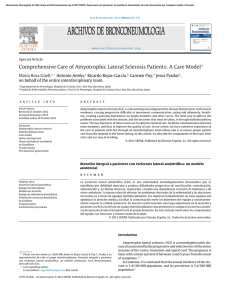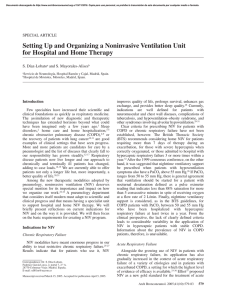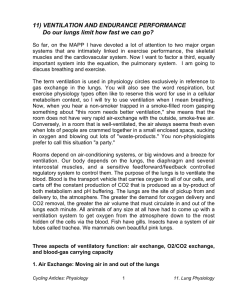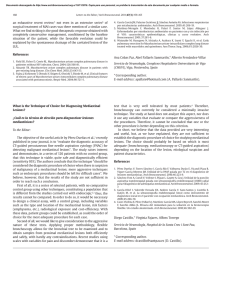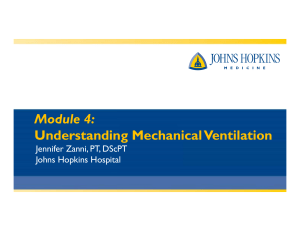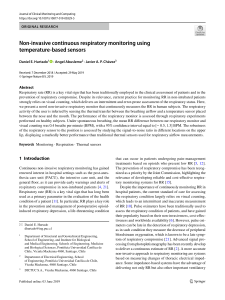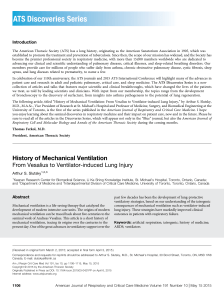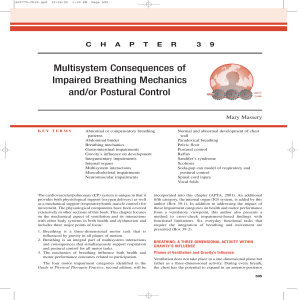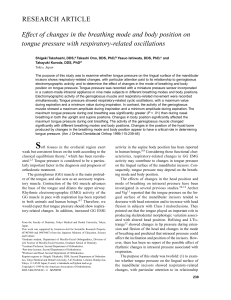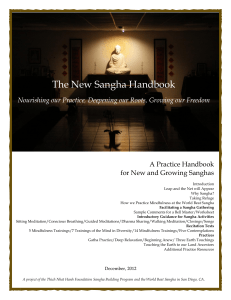The Breathing Pattern, an Old Friend Full of Information – But How
Anuncio
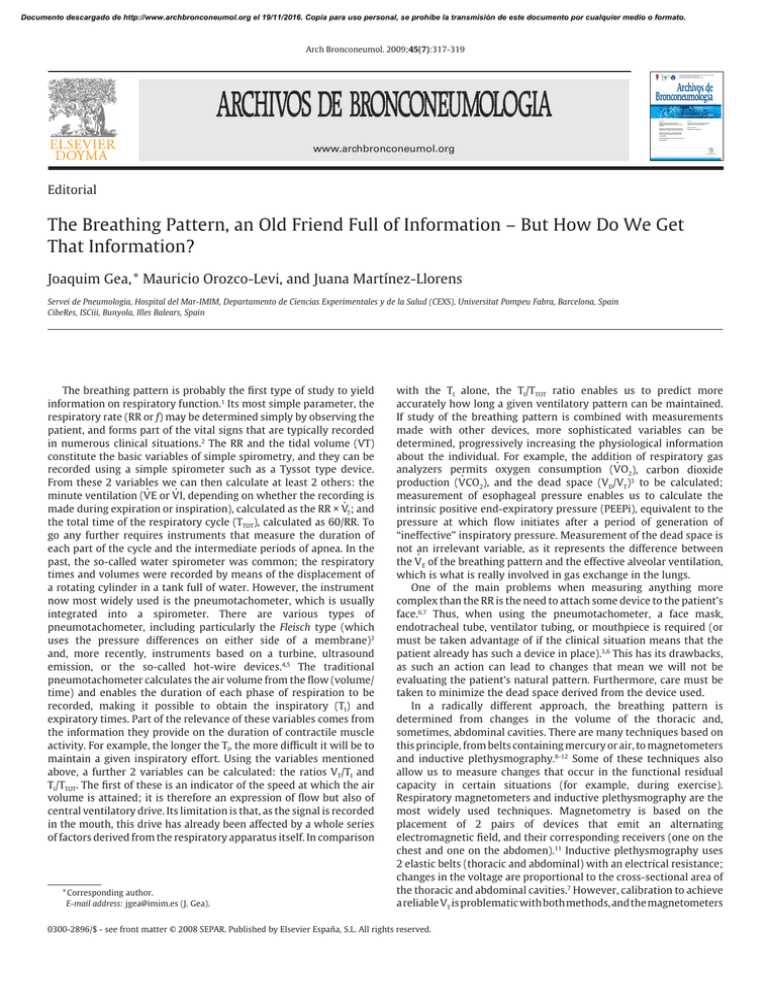
Documento descargado de http://www.archbronconeumol.org el 19/11/2016. Copia para uso personal, se prohíbe la transmisión de este documento por cualquier medio o formato. Arch Bronconeumol. 2009;45(7):317-319 Archivos de Bronconeumología Órgano Oficial de la Sociedad Española de Neumología y Cirugía Torácica (SEPAR), la Asociación Latinoamericana del Tórax (ALAT) y la Asociación Iberoamericana de Cirugía Torácica (AIACT) Archivos de Bronconeumología ISSN: 0300-2896 Volumen 45, Número Originales Revisión Medición del patrón ventilatorio mediante tomografía por impedancia eléctrica en pacientes con EPOC El cáncer de pulmón en España. Epidemiología, supervivencia y tratamiento actuales Utilidad de la videotoracoscopia para una correcta estadificación de tumores T3 por invasión de pared Julio 2009. Volumen 45. Número 7, Págs 313-362 www.archbronconeumol.org 7, Julio 2009 Artículo especial Evaluación de la somnolencia Características clínicas y polisomnográficas del síndrome de apneas durante el sueño localizado en la fase REM Trasplante de pulmón en casos de enfisema: análisis de la mortalidad www.archbronconeumol.org Incluida en: Excerpta Medica/EMBASE, Index Medicus/MEDLINE, Current Contents/Clinical Medicine, ISI Alerting Services, Science Citation Index Expanded, Journal Citation Reports, SCOPUS, ScienceDirect Editorial The Breathing Pattern, an Old Friend Full of Information – But How Do We Get That Information? Joaquim Gea, * Mauricio Orozco-Levi, and Juana Martínez-Llorens Servei de Pneumologia, Hospital del Mar-IMIM, Departamento de Ciencias Experimentales y de la Salud (CEXS), Universitat Pompeu Fabra, Barcelona, Spain CibeRes, ISCiii, Bunyola, Illes Balears, Spain The breathing pattern is probably the irst type of study to yield information on respiratory function.1 Its most simple parameter, the respiratory rate (RR or f) may be determined simply by observing the patient, and forms part of the vital signs that are typically recorded in numerous clinical situations.2 The RR and the tidal volume (VT) constitute the basic variables of simple spirometry, and they can be recorded using a simple spirometer such as a Tyssot type device. From these 2 variables . we. can then calculate at least 2 others: the minute ventilation (V E or V I, depending on whether the recording is · made during expiration or inspiration), calculated as the RR × VT; and the total time of the respiratory cycle (TTOT), calculated as 60/RR. To go any further requires instruments that measure the duration of each part of the cycle and the intermediate periods of apnea. In the past, the so-called water spirometer was common; the respiratory times and volumes were recorded by means of the displacement of a rotating cylinder in a tank full of water. However, the instrument now most widely used is the pneumotachometer, which is usually integrated into a spirometer. There are various types of pneumotachometer, including particularly the Fleisch type (which uses the pressure differences on either side of a membrane)3 and, more recently, instruments based on a turbine, ultrasound emission, or the so-called hot-wire devices.4,5 The traditional pneumotachometer calculates the air volume from the low (volume/ time) and enables the duration of each phase of respiration to be recorded, making it possible to obtain the inspiratory (TI) and expiratory times. Part of the relevance of these variables comes from the information they provide on the duration of contractile muscle activity. For example, the longer the TI, the more diicult it will be to maintain a given inspiratory effort. Using the variables mentioned above, a further 2 variables can be calculated: the ratios VT/TI and TI/TTOT. The irst of these is an indicator of the speed at which the air volume is attained; it is therefore an expression of low but also of central ventilatory drive. Its limitation is that, as the signal is recorded in the mouth, this drive has already been affected by a whole series of factors derived from the respiratory apparatus itself. In comparison * Corresponding author. E-mail address: jgea@imim.es (J. Gea). with the TI alone, the TI/TTOT ratio enables us to predict more accurately how long a given ventilatory pattern can be maintained. If study of the breathing pattern is combined with measurements made with other devices, more sophisticated variables can be determined, progressively increasing the physiological information about the individual. For example, the addition of respiratory gas . analyzers permits oxygen consumption (V O ), carbon dioxide 2 . production (V CO2), and the dead space (VD/VT)3 to be calculated; measurement of esophageal pressure enables us to calculate the intrinsic positive end-expiratory pressure (PEEPi), equivalent to the pressure at which low initiates after a period of generation of “ineffective” inspiratory pressure. Measurement of the dead space is not an . irrelevant variable, as it represents the difference between the V E of the breathing pattern and the effective alveolar ventilation, which is what is really involved in gas exchange in the lungs. One of the main problems when measuring anything more complex than the RR is the need to attach some device to the patient’s face.6,7 Thus, when using the pneumotachometer, a face mask, endotracheal tube, ventilator tubing, or mouthpiece is required (or must be taken advantage of if the clinical situation means that the patient already has such a device in place).3,6 This has its drawbacks, as such an action can lead to changes that mean we will not be evaluating the patient’s natural pattern. Furthermore, care must be taken to minimize the dead space derived from the device used. In a radically different approach, the breathing pattern is determined from changes in the volume of the thoracic and, sometimes, abdominal cavities. There are many techniques based on this principle, from belts containing mercury or air, to magnetometers and inductive plethysmography.8-12 Some of these techniques also allow us to measure changes that occur in the functional residual capacity in certain situations (for example, during exercise). Respiratory magnetometers and inductive plethysmography are the most widely used techniques. Magnetometry is based on the placement of 2 pairs of devices that emit an alternating electromagnetic ield, and their corresponding receivers (one on the chest and one on the abdomen).11 Inductive plethysmography uses 2 elastic belts (thoracic and abdominal) with an electrical resistance; changes in the voltage are proportional to the cross-sectional area of the thoracic and abdominal cavities.7 However, calibration to achieve a reliable VT is problematic with both methods, and the magnetometers 0300-2896/$ - see front matter © 2008 SEPAR. Published by Elsevier España, S.L. All rights reserved. Documento descargado de http://www.archbronconeumol.org el 19/11/2016. Copia para uso personal, se prohíbe la transmisión de este documento por cualquier medio o formato. 318 J. Gea et al / Arch Bronconeumol. 2009;45(7):317-319 or elastic belts must not be displaced during measurement. Thus, although they can be useful in a basal situation,13 one of the main limitations arises from the fact that it is diicult to obtain valid measurements if movement occurs (for example, during exercise). At the present time, they are mainly used for breathing studies during sleep, to evaluate thoracic and abdominal movements during apnea. However, in this context they are being progressively substituted by technology based on piezoelectric crystals. Another method that does not require the use of facial devices is electrical impedance tomography, in which the breathing pattern is derived from a sequence of images obtained by recording a low intensity alternating current. The article by Balleza et al14 published in this issue of Archivos de Bronconeumología is the continuation of a previous study15 in which the authors compared this technique with the pneumotachometer for recording the breathing pattern in healthy individuals. In that study, they found that electrical impedance tomography was a promising method, though it still had signiicant limitations that prevented it from being considered a valid alternative.16 These limitations included the need to take into account the speciic characteristics of the chest wall of the individual under study.17,18 In the study published in this issue,14 the same research group has used the electrical impedance tomography technique on patients with chronic obstructive pulmonary disease. A speciic characteristic of these patients is the geometric changes in the coniguration of the chest wall caused by the increase in lung volume.19 The authors have identiied carbon monoxide transfer factor, one of the markers commonly used in pulmonary emphysema, as a variable to correct for the differences between electrical impedance tomography and the pneumotachometer when measuring VT. In contrast, this correction apparently cannot be used when measuring the degree of air trapping. The authors indicate that, for the time being, until the problems of calibration are deinitively resolved, electrical impedance tomography may be useful for the follow-up of changes in the breathing pattern but not for the measurement of absolute values of VT. Finally, a new method has appeared recently that is based on changes induced by the breathing pattern on the image generated by vibrations related to lung sounds (vibration response imaging).20 This technique, which also reveals the distribution of ventilation within the lungs, still requires clear validation before it can be used for measuring the breathing pattern. Traditional body plethysmography systems have also be used in order to avoid the application of devices to the face. These systems are based on a ixed-volume chamber in which the patient receives a known airlow; the changes in lung volume are calculated from the changes in pressure. This technique is mainly used in animal models. As has been mentioned above, an important aspect in the use of all these instruments is their preparation and calibration—the accuracy of the measurements depends on this. In order to achieve the most reliable possible record of the resting breathing pattern, it is also important for the subject to be in a steady-state situation before performing the measurements. It should also be remembered that telemetry can be used with all the methods mentioned. This technique allows remote recordings to be made; this can be particularly useful in sleep studies, in ieldwork that includes exercise testing outside the laboratory, and for monitoring of the breathing pattern in the patient’s home.21 Finally, it should be mentioned that there are other devices that enable us to measure the time variables of the breathing pattern, although they do not give reliable indications of the lung volumes. One of these devices is the thermistor (based on changes in temperature of the airlow in the oronasal region).22 A similar situation exists with the various means of recording the respiratory pressures (nasal specs, esophageal catheters, etc).23 Study of the changes that occur in the breathing pattern in response to certain stimuli is an interesting subject. The information obtained is very useful for investigating the control of breathing24; the most extensively used stimuli are those of a chemical nature, through respiration of hypoxic or hypercapnic mixtures.25 Hypoxic mixtures usually contain around 10% of oxygen and are designed to evaluate the response of the peripheral chemoreceptors. The chemoreceptors situated in the carotid artery appear to respond principally to the PaO2, whereas those of the aorta respond to the total content of the gas. Hypoxia leads to an increase in ventilation, particularly once signiicant values are reached (PaO2<50-60 mm Hg) and if the partial pressure of carbon dioxide remains stable. For their part, hypercapnic stimuli, usually produced using mixtures containing 5%-8% carbon dioxide, lead to an increase in ventilation through central mechanisms linked to the chemosensitive region of the brainstem. This response can also be modulated by the concomitant presence of hypoxia and by the local cerebral blood low. Much less frequently the ventilatory stimuli are based on an imbalance in acid/base homoeostasis; this is achieved by the infusion of a substance with a low pH. Another alternative is to ask the subject to voluntarily attempt to achieve maximum possible ventilation. These techniques enable us to measure what is known as the maximum voluntary ventilation, which is a good indicator of the ventilatory reserve.26 The responses to all these stimuli will obviously depend on the . situation of the subjects and on whether they are able to increase V E by increasing VT (the more eicient method), or are forced to depend almost exclusively on increasing their RR. There are many possible applications of study of the breathing pattern. In addition to the use of the RR in daily practice and in common studies such as polysomnography, slow spirometry, and exercise tests,27,28 the breathing pattern can be useful in hypercapnic patients in general, and particularly in those with alveolar hypoventilation, alterations of the chest wall, extreme obesity, or neurological or neuromuscular diseases.29 It is also useful for the evaluation of certain treatments, such as muscle training30,31 or mechanical ventilation (invasive or otherwise)32 in patients with various respiratory diseases. In summary, the breathing pattern is of considerable use both in physiological studies and in respiratory medicine. There are numerous techniques that enable us to determine the variables of the breathing pattern, although the reference technique is pneumotachometry, which requires some sort of facial device. A number of alternative techniques are available that avoid distortion due to facial devices. Although the most widely used of these alternative techniques have been respiratory magnetometry and invasive plethysmography, new instruments have been developed in recent years, such as vibration response imaging and electrical impedance tomography. This last test is in the development phase, but appears promising if it can overcome the inherent problems of calibration. References 1. Milic-Emili J. Recent advantages in clinical assessment of control of breathing. Lung. 1982;160:1-17. 2. Milic-Emili G, Cajani F. Frequency of breathing as a function of respiratory ventilation during rest. Boll Soc Ital Biol Sper. 1957;33:821-5. 3. Burki NK. Measurements of ventilatory regulation. Clin Chest Med. 1989;10:21526. 4. Jones KP, Mullee MA. Measuring peak expiratory low in general practice: comparison of mini Wright peak low meter and turbine spirometer. BMJ. 1990;300:1629-31. 5. Giner J. Espirometría y volúmenes pulmonares. In: Plaza V, Rodrigo JG, Casan P, García Río F, Gea Guiral J, editors. Fisiología y biología respiratorias. Madrid: Ergon; 2007. p. 31-9. 6. Perez W, Tobin MJ. Separation of the factors responsible for change in breathing pattern induced by instrumentation. J Appl Physiol. 1985;59:1515-20. 7. McCool FD. Noninvasive methods for measuring ventilation. In: Roussos C, editor. The thorax. Part B: applied physiology. New York: Marcel Dekker Inc.; 1995. p. 1049-69. 8. Wade DL. Movements of the thoracic cage and diaphragm in respiration. J Physiol. 1954;124:193. Documento descargado de http://www.archbronconeumol.org el 19/11/2016. Copia para uso personal, se prohíbe la transmisión de este documento por cualquier medio o formato. J. Gea et al / Arch Bronconeumol. 2009;45(7):317-319 9. Bendixon HH, Smith GM, Mead J. Pattern of ventilation in young adults. J Appl Physiol. 1964;19:195-8. 10. Shaphiro A, Cohen H. The use of mercury capillary length gauges for the measurement of the volume of thoracic and diaphragmatic components of human respiration: a theoretical analysis and a practical method. Trans NY Acad Sci. 1965;27:634-49. 11. Stagg D, Goldman M, Davis JN. Computer-aided measurement of breath volume and time components using magnetometers. J Appl Physiol. 1978;44:623-33. 12. Milledge JS, Stott FD. Inductive plethysmography: a new respiratory transducer. J Physiol. 1977;267:4P-5P. 13. Stick SM, Ellis E, LeBoeuf PN, Sly PD. Validation of respiratory inductance plethysmography (“Respitrace”) for the measurement of tidal breathing parameters in newborn. Pediatr Pulmonol. 1992;13:187-91. 14. Balleza M, Feixas T, Calf N, Antón D, Riu PJ, Casan P. Medición del patrón ventilatorio (PV) mediante tomografía por impedancia eléctrica (TIE) en pacientes con EPOC. Arch Bronconeumol. 2009;45:320-4. 15. Balleza M, Fornos J, Calaf N, Freixas T, González M, Antón D, et al. Seguimiento del patrón ventilatorio en reposo mediante tomografía por impedancia eléctrica. Arch Bronconeumol. 2007;43:300-3. 16. Nebuya S, Kitamura K, Kobayashi H, Noshiro M, Brown BH. Measurement accuracy in pulmonary function test using impedance tomography. IFMBE Proc. 2007; 17:539-42. 17. Balleza M, Fornos J, Calaf N, Feixas T, González M, Antón D, et al. Ventilatory pattern monitoring with electrical impedance tomography (EIT). Validation for healthy subjects. IFMBE Proc. 2007;17:572-5. 18. Frerich I. Electrical impedance tomography (EIT) in applications related to lung and ventilation: a review of experimental and clinical activities. Physiol Meas. 2000;21:1-21. 19. Canal M, Gea J. Enfermedades del diafragma y de los músculos respiratorios. In: Rozman C, Cardellach F, editors. Farreras-Rozman: medicina interna. Barcelona: Elsevier; 2008. p. 857-61. 20. Dellinger RP, Smith J, Cinel I, Tay C, Rajanala S, Glckman YA, et al. Regional distribution of acoustic-based lung vibration as a function of mechanical ventilation mode. Crit Care. 2007;11:R26. 319 21. Farré R. Telemedicina y enfermedades respiratorias durante el sueño: perspectivas de futuro. Arch Bronconeumol. 2009;45:105-6. 22. Farré R, Montserrat JM, Rotger M, Ballester E, Navajas D. Accuracy of thermistors and thermocouples as low-measuring devices for detecting hypopnoeas. Eur Respir J. 1998;11:179-82. 23. Montserrat JM, Farré R, Ballester E, Félez MA, Pastó M, Navajas D. Evaluation of nasal prongs for estimating nasal low. Am J Respir Crit Care Med. 1997;155:211-5. 24. Folgering H. Studying the control of breathing in man. Eur Respir J. 1988;1:65160. 25. García-Río F, Rojo B, Pino JM. Control de la ventilación. In: Plaza V, Rodrigo JG, Casan P, García Río F, Gea Guiral J, editors. Fisiología y biología respiratorias. Madrid: Ergon; 2007. p. 141-61. 26. Grassino A, Gea J. Evaluación de la resistencia y fatiga de los músculos inspiratorios. In: Pino JM, García-Río F, editors. Músculos respiratorios. Estudio de la función respiratoria. Madrid: Sanitaria; 2000. p. 121-33. 27. Benito PJ, Calderón FJ, García-Zapico A, Legido JC, Caballero JA. Respuesta de la relación volumen corriente-tiempo inspiratorio durante el esfuerzo incremental. Arch Bronconeumol. 2006;42:62-7. 28. González-García M, Barrero M, Maldonado D. Limitación a la tolerancia al ejercicio en pacientes con EPOC a la altura de Bogotá (2.640 m). Patrón ventilatorio y gasometría arterial en reposo y en ejercicio pico. Arch Bronconeumol. 2004;40:5461. 29. Fregonezi GA, Regiane-Resqueti V, Pradas J, Vigil L, Casan P. Relación entre función pulmonar y calidad de vida relacionada con la salud en la miastenia gravis generalizada. Arch Bronconeumol. 2006;42:218-24. 30. Ruiz JM, García J, Puente-Maestu L, Llorente D, Celdrán J, Cubillo JM. Efectos del entrenamiento muscular sobre el patrón ventilatorio en pacientes con enfermedad pulmonar obstructiva crónica grave. Arch Bronconeumol. 2004;40:20-3. 31. Madariaga VB, Gáldiz JB, Manterola AG, Buey JC, Sebastián NT, Peña VS. Comparación de dos métodos de entrenamiento muscular inspiratorio en pacientes con EPOC. Arch Bronconeumol. 2007;43:431-8. 32. Neme JY, Gutiérrez AM, Santos MC, Berón M, Ekroth C, Arcos JP, et al. Efectos isiológicos de la ventilación no invasiva en pacientes con EPOC. Arch Bronconeumol. 2007;43:150-5.
